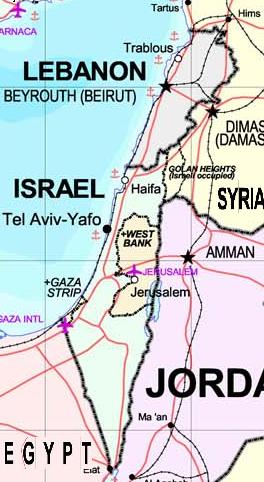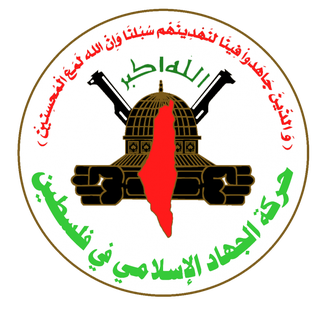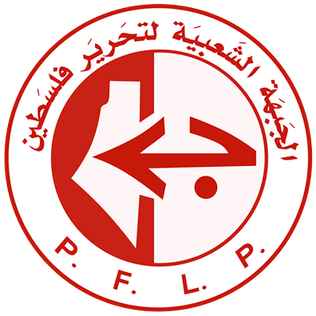
The Popular Front for the Liberation of Palestine – General Command or PFLP-GC is a Palestinian nationalist militant organisation based in Syria.

Ahmed Jibril was a Palestinian militant and political leader who was the founder and leader of the Popular Front for the Liberation of Palestine – General Command (PFLP-GC).
The Rejectionist Front or Front of the Palestinian Forces Rejecting Solutions of Surrender was a political coalition formed in 1974 by radical Palestinian factions who rejected the Ten Point Program adopted by the Palestine Liberation Organization (PLO) in its 12th Palestinian National Congress (PNC) session.
Ain al-Hilweh, also spelled as Ayn al-Hilweh and Ein al-Hilweh, is the largest Palestinian refugee camp in Lebanon. It had a population of over 70,000 Palestinian refugees but swelled to nearly 120,000, as a result of influx of refugees from Syria since 2011. The camp is located west of the village Miye ou Miye and the Mieh Mieh refugee camp, southeast of the port city of Sidon and north of Darb Es Sim.

The Israeli–Lebanese conflict, or the South Lebanon conflict, is a series of military clashes involving Israel, Lebanon and Syria, the Palestine Liberation Organization, as well as various militias and Militants acting from within Lebanon. The conflict peaked in the 1980s, during the Lebanese Civil War, and has abated since.

The South Lebanon conflict, designated by Israel as the Security Zone in Lebanon Campaign, was a protracted armed conflict that took place in southern Lebanon from 1985 to 2000. It saw fighting between Israel and the Catholic Christian-dominated South Lebanon Army (SLA) against Hezbollah-led Shia Muslim and left-wing guerillas within the Israeli-occupied "Security Zone"; the SLA had military and logistical support from the Israel Defense Forces over the course of the conflict and operated under the jurisdiction of the Israeli-backed South Lebanon provisional administration, which succeeded the earlier Israeli-backed State of Free Lebanon. It can also refer to the continuation of the earlier conflict in this region involving the growing Palestinian insurgency in South Lebanon against Israel following the expulsion of the Palestine Liberation Organization (PLO) from Jordan after Black September. Historical tensions between Palestinian refugees and Lebanese factions contributed another layer to the Lebanese Civil War (1975–1990), which saw the Maronite-led Lebanese Front and the Shia Amal Movement at war with the PLO. Hence, the South Lebanon conflict can partly be seen as an extension of the civil war that ended in 1990.
This is the Timeline of the Israeli–Palestinian conflict in 2007.

The Islamic Jihad Movement in Palestine, commonly known simply as Palestinian Islamic Jihad (PIJ), is a Palestinian Islamist paramilitary organization formed in 1981.

Palestinian fedayeen are militants or guerrillas of a nationalist orientation from among the Palestinian people. Most Palestinians consider the fedayeen to be "freedom fighters", while most Israelis consider them to be "terrorists".

The History of the Israel Air Force begins in May 1948, shortly after the formation of the State of Israel. Following Israel's declaration of independence on May 14, its pre-state national institutions transformed into the agencies of a state, and on May 26, 1948, the Israeli Air Force was formed. Beginning with a small collection of light aircraft, the force soon transformed into a comprehensive fighting force. It has since participated in several wars and numerous engagements, becoming what has been described as "The mightiest air force in the Middle East".
The Battle of Yarmouk Camp was a period of fierce clashes in Yarmouk Camp during the Syrian civil war. Yarmouk is a district of Damascus that is home to the biggest community of Palestinian refugees in Syria. The fighting was between the Syrian Army and PFLP-GC on one side, and Syrian rebels on the other. The rebels included the Free Syrian Army (FSA) and a group made up of Palestinians, called Liwa al-Asifa or Storm Brigade. On 17 December, it was reported that the FSA and anti-Assad Palestinians had taken control of the camp. The FSA and Syrian Army agreed to leave Yarmouk as a neutral, demilitarized zone, but sporadic clashes continued.

The Jihad Jibril Brigades form the paramilitary branch of the Popular Front for the Liberation of Palestine – General Command (PFLP-CG). They are named after Jihad Ahmed Jibril, the son of founder Ahmed Jibril and former head of the brigades, who died in an car bombing in Beirut in 2002. Their symbolism is the flag of the PFLP-CG in black and white.

The Popular Front for the Liberation of Palestine (PFLP) is a secular Palestinian Marxist–Leninist and revolutionary socialist organization founded in 1967 by George Habash. It has consistently been the second-largest of the groups forming the Palestine Liberation Organization, the largest being Fatah.
Events in the year 2015 in Israel.
The Alliance of Palestinian Forces is a Damascus-based loose political alliance of eight Palestinian organizations. The Alliance was created in Damascus in December 1993 by ten Palestinian factions opposed to the negotiations that led up to the Oslo Accords. Amongst the ten founding members all but Hamas were headquartered in Damascus. Eight of the founding members were previously members of the Palestine Liberation Organization (PLO), the other two being Hamas and Palestinian Islamic Jihad.
The Iran–Israel conflict during the Syrian civil war refers to the Iranian–Israeli standoff in and around Syria during the Syrian conflict. With increasing Iranian involvement in Syria from 2011 onwards, the conflict shifted from a proxy war into a direct confrontation by early 2018.







